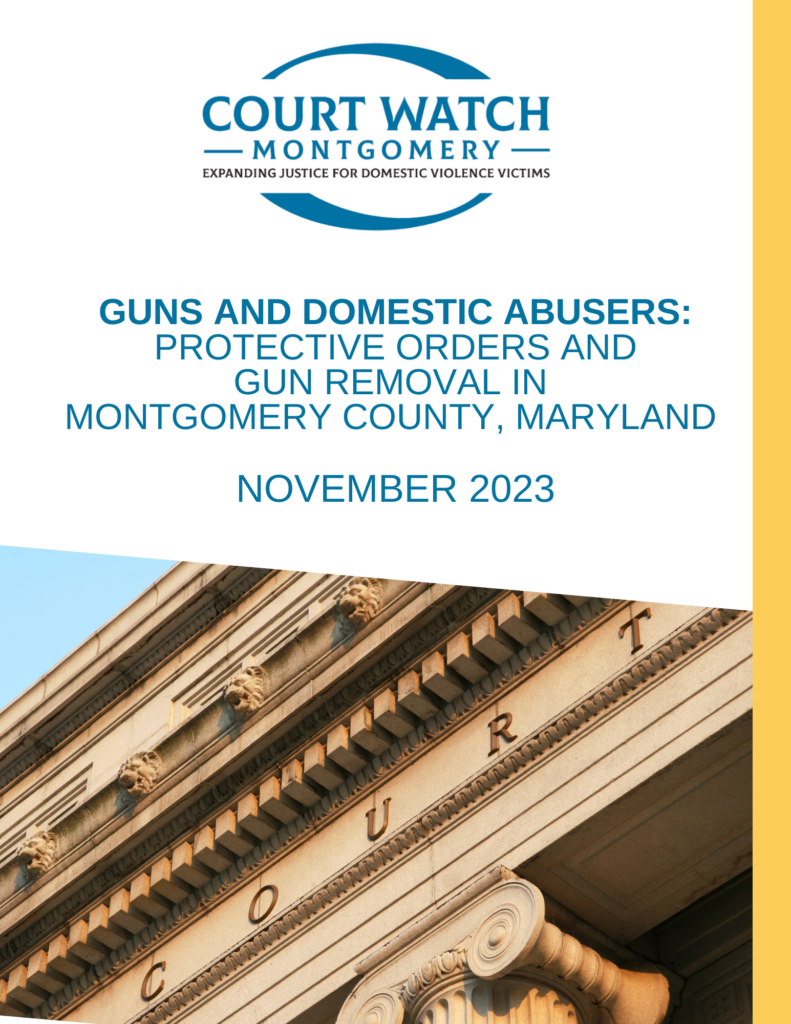Guns and Domestic Abusers: Protective Orders and Gun Removal in Montgomery County, Maryland

Recognizing the extreme danger of guns in domestic violence situations, and the risk to victim safety posed by the Rahimi case, we believe it is timely to report on relevant laws in Maryland and practices in Montgomery County to keep firearms away from domestic abusers through use of civil protective orders. Part I of this report presents an overview of federal and Maryland law governing domestic violence protective orders and firearms, followed by a description of the protective order process in Maryland and procedures used by the Montgomery County Sheriff’s Office to serve orders and remove guns. Data on the number of guns removed from abusers in Montgomery County also are presented. Part II of the report presents findings on the use of gun-related best practices by District Court judges at protective order hearings, based on data collected by Court Watch volunteers and our review of the protective order service process in Montgomery County. Conclusions and recommendations to address these findings are included at the end of the report.
2023 Staggered Exit Supplement: Montgomery County District Court Increased Use of Staggered Exits in Intimate Partner Violence Hearings from 2022 to 2023

Staggered exits are a nationally recognized best practice intended to keep victims safe, allowing them to leave the courtroom first after a protective order hearing, with their alleged offender leaving no sooner than 15 minutes thereafter. When properly executed, staggered exits reduce the risk of confrontation between the parties outside the courtroom and enable victims and their families to get safely to their transportation home. Staggered exits can help lessen trauma and increase the likelihood that victims will return to court when necessary to obtain a final order. Court Watch has seen the use of staggered exits fluctuate by year and vary by judge, despite the fact that they are cost-free and pose no significant burden to the courts. In our 2023 supplement, we are pleased to report that use of staggered exits in Montgomery County District Court increased by 20 percentage points in the one year since we last reported on use of this best practice. We applaud the judiciary’s commitment to use of this safe and free protocol.
Staggered Exit Report: Montgomery County District Courts Fail to Consistently Implement Recommended Safety Practice

Staggered exits are a nationally recognized best practice intended to keep victims safe, allowing them to leave the courtroom first after a protective order hearing, with their alleged offender leaving no sooner than 15 minutes thereafter. When properly executed, staggered exits reduce the risk of confrontation between the parties outside the courtroom and enable victims and their families to get safely to their transportation home. Staggered exits can help lessen trauma and increase the likelihood that victims will return to court when necessary to obtain a final order.
Court Watch has seen the use of staggered exits fluctuate by year and vary by judge, despite the fact that they are cost-free and pose no significant burden to the courts. As the courts emerge from Covid-related closures and parties return to in-person hearings, a renewed focus on staggered exits is timely. This report demonstrates that use of staggered exits in Montgomery County has continued to decline, even though the practice is recommended by the Maryland Judiciary and supported by the Montgomery Court District Courts.
Do domestic violence victims in Montgomery County have full access to justice? A look at District Court judges use of five fundamental practices

In this report, which analyses data collected in over 2,500 protective order hearings in Montgomery
County’s District Courts between September of 2016 and April of 2018, Court Watch examines judges’
use of the five fundamental best practices we first recommended in 2011. Notably, shortly after
publication of our 2011 report, in 2012, Maryland’s Chief Judge of the District Courts, the Honorable Ben
Clyburn, sent every District Court Judge a “bench card” urging them to adopt the very same best
practices we identified. Yet, in this current study, domestic violence victims are protected as they leave
the court house far less often than they were in 2012 – in fewer than half of cases. While judges have
improved greatly in engaging victims who wish to dismiss their cases about their safety, other
fundamental best practices have remained at about the same low level they were in 2011. Of particular
concern is that usage of staggered exits continues to vary widely by judge, with one judge staggering
exits 68% of the time, while a second only used staggers 24% of the time. Among our other
recommendations, we urge the District Courts to adopt a more uniform use of this basic safety protocol,
or to adopt a County wide policy to ensure judges stagger exits 100% of the time.
Extremely dangerous precedent in TX protective order court
The Washington Post reports that last week (Feb. 2017) half a dozen Immigration and Customs Enforcement (ICE) agents showed up in a Texas courtroom where an undocumented woman was seeking a protective order against her boyfriend for punching, kicking, choking and attempting to stab her. The agents arrested her. Both the El Paso County Attorney and […]
District Court judges and bailiffs provide safe exits only 56% of the time
Staggering exits at the end of every domestic violence court hearing is a simple procedure. Bailiffs can keep victims safe by holding respondents for at least 10 minutes after the petitioner leaves the courtroom. When bailiffs don’t stagger exits, many survivors are harassed or assaulted by angry abusers on the way to their cars or buses. Staggering […]
Maryland child deaths related to intimate partner violence 2004-2016

This report documents the tragic deaths of 35 children state-wide in intimate partner related violence.
Almost a third were killed during dangerous court-ordered exchanges for visitation or during
unsupervised visits with dangerous or unstable parents. Court watch reiterates that these deaths might
have been preventable were safe visitation services widely available. Increasing the number of domestic
violence victims that have viable safety plans and strong protective orders would also help prevent such
deaths.
Particularly unsafe day in criminal domestic violence court

Some criminal domestic violence dockets go more smoothly than others. It was infuriating last week to see what happened to a victim who took the brave step to come to court to testify against her former partner, who was charged with violating her protective order six times. The defendant’s criminal record included numerous assault charges, carrying a concealed […]
Progress on safe child exchange services
Survivors of domestic violence need safe places they can go to transfer their children for visits with the other parent without experiencing fear or injury. Court Watch leaders had a good meeting today with County Councilmember George Leventhal, Sheriff Popkin, Uma Ahluwalia (Director of DHSS) and their staffs. We discussed the urgent need for safe exchange […]
Where are the victims in dv criminal court?
Last week during District Court’s criminal dv docket the State’s Attorney’s Office prosecutors did their level best to present evidence showing grounds for conviction in each case they pursued. On this particular day, however, there was not a single victim present in the courtroom to testify. Going to court to face an abuser is an emotional […]